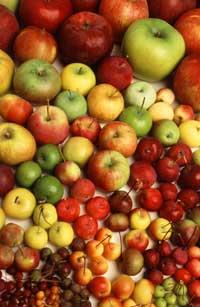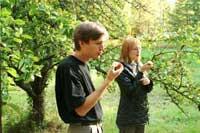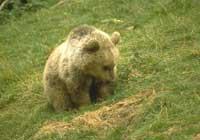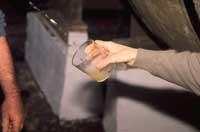Genetic history of apple and cider chemistry

Apple is still one of the most appreciated fruits. It is one of the main fruits of temperate and cold climates, with thousands of varieties: suitable for raw food, suitable for cider making, special for preparing jams and jams... The scientists were eager to know where so many varieties came from, and in the end they have gone to genetics to clarify the evolution of the apple tree. In fact, in the journal specializing in genetics Trends in Genetics, North American scientists have published an investigation based on the study of the DNA of apple trees. It explains the route from wild apple trees to today's apple trees.
Long ago, in 1930, a researcher named Vavilov proposed that domesticated apple trees come from the wild apple trees of central Asia, specifically from Turkish lands (Kazakhstan, Kyrgyzstan, Uzbekistan, Turkmenistan and Tadjikistan). Below are the historical data that fit this theory, but its affirmation has not been possible. Now, thanks to genetic studies, it has been shown that Vavilov worked properly.
Apple and cherry bears
The wild apple from central Asia is directly related to other apple trees that provide fruits of different sizes. One of them is the Siberian Malus baccata. The fruits of this tree are small and red and are hung in clusters of branches that are the birds responsible for their diffusion. In its day, this tree was more widespread than today and, it is believed, was trapped in that territory when the Tein Shan rose over the Tethis Ocean, which separated Gondwana and Laurasia.

For seven million years, even ten million years, bears and other mammals extended this fruit and chose the richest and most beautiful specimens. In this way, being a small cherry shaped fruit that was distributed by the birds, it was chosen to become a larger fruit. The researchers have found that small apples pass through the mouth and intestine without any change and it must be taken into account that the seeds that remain in the heart of the apple do not germinate. Therefore, large mammals only helped to expand large specimens.
Between 5,000 and 8,000 years ago, when man conquered this territory, the apple had a complete evolution. Migration was also taking place thanks to the now domesticated horse. Since then, the selection that has been made for thousands of years has been through intentional and unintended actions. Hence there are so many varieties.
Archaeological and molecular data appear to indicate that the wild apple reached Europe in the Neolithic or early Bronze Age. Apparently, the seeds were transported in the loads of the horses or in the intestine on the commercial road that was heading from the center of China to Danube. Now, researchers know that 3,800 years ago they knew the technique of vaccination in Mesopotamia, so it is very likely that the apple will be tamed then. Then, the Persians, Greeks, and Romans opened the domestic apple varieties and improved the apple trees.

However, in Europe archeological indications of wild apple species have been collected, both in the Neolithic period (11.200 years ago) and in the Bronze Age (4,500 years ago). a.C. By the year 1000 there were already apple trees planted in Israel.
This research based on genetic studies has served to confirm what was known thanks to archaeological data, but the authors themselves recognize that they still have much to investigate and clarify.
The apple in Euskal Herria
Experts do not match the date of the apple in Euskal Herria. In any case, the importance of this fruit in Euskal Herria is evident; cider is not called “Basque national drink”. The problem is that Euskal Herria is also investigating the apple. In the UPV, a chemical and microbiological study of cider is being carried out. With the aim of analyzing the whole process of cider making, in addition to analyzing raw materials, fermentation and its evolution in the bottle are being investigated.
As for the apple, Txalaka, Moko, Goikoetxea and 20 other types of apple have been used. The work of the researchers has consisted in measuring the ingredients that confer sweetness, acidity and bitterness to apples. In this way, we have been able to know the characteristics of each type of apple.

Then the fermentation has been followed and the normal press has been compared with the pneumatic press, as well as the barrel of wood and steel. The influence of the apple mixture on the final apple has also been measured. And finally it has wanted to know what has happened once bottled.
Undoubtedly, the conclusions of the study will be very interesting for the sidreros. On the one hand, researchers have found that the pneumatic press offers a better result than the traditional one. On the other hand, although not all agree, it seems that steel barrels are better than wood barrels because the temperature is better controlled and are cleaner. As for apple mixtures, they have realized that you have to look for a balance: if you use too much slow apple you easily lose the cider and with many acids and bites it costs a lot to grab it.
Now the last word is had by the sidreros who will decide what to do with the fruits of the apples. And we will taste the result (it is free to comment). Happy! News News News
Published in 7K.
Buletina
Bidali zure helbide elektronikoa eta jaso asteroko buletina zure sarrera-ontzian











